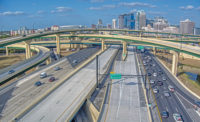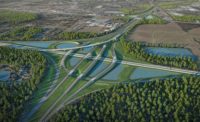Infrastructure Spending Helping Drive Southeast Design Markets

Gensler recently released a rendering of its design for the 50-story Riverwalk Place, which would be Tampa’s tallest tower.
IMAGE COURTESY GENSLER

Sfl+a Architects, designers of the energy-positive Socastee Middle School in Myrtle Beach, S.C., is one of the firms participating in ENR Southeast's Top Design Firms survey.
IMAGE COURTESY SFL+A ARCHITECTS


Architectural and engineering firms working in the Southeast are continuing to secure work across a variety of still-steady market sectors, based on the results of ENR Southeast’s most recent Top Design Firms survey. Notably, Southeast engineering and architectural firms collectively reported more than $5.4 billion in regional revenue for 2017, an increase of roughly 20 percent compared with the $4.5 billion included in the ranking that was published a year ago.
Much of that growth was concentrated among the top 20-ranked firms. This year’s survey revealed that these firms reported more than $3.3 billion in design revenue. By comparison, the ranking published in 2017 saw the top 20 report roughly $2.76 billion in Southeast revenue.
And for now, at least, the prospects for future work appear to be bright.
“Most sectors seem to be doing well on the infrastructure and buildings sides for both public and private clients,” says John Bottaro, executive vice president with Jacksonville, Fla.-based RS&H, adding that most of the region’s metropolitan areas are showing significant activity. “While Southeast Florida appears most active, the major metros in the Southeast are all pretty steady right now.”
Noting across-the-board strength in his firm’s current backlog, Bottaro adds, “We see future opportunities remaining strong.”
Infrastructure spending could be an area of continued focus for the region’s engineering firms, multiple sources told ENR Southeast.
“Transportation is a robust sector driven by hot markets such as North Carolina, which is benefiting from a focus on decentralization of (design) work, and Georgia, where the benefits of passing a gas tax in 2015 are driving an increase in available revenue and spending,” says Tim Keener, AECOM executive vice president for the Southeast.
Work in that market could remain strong across the region for awhile. “Transportation is strong, driven by tremendous need, some increase in local gas tax revenue and technology as we move into smart highways and vehicles,” Keener says.
Infrastructure’s strength is broader than just the transportation sector, adds Darren Conner, Southeast president for engineering consulting firm Dewberry.
“We see robust infrastructure spend in transportation and water,” Conner says.
Delivery methods for transportation projects appear to be in transition, with approaches varying across the region.
For this sector, Conner says, “We’re continuing to see design-build used for a healthy portion of the program delivery in North Carolina, South Carolina and Georgia,” with a focus on accelerating schedules, promoting innovative approaches and streamlining the environmental review process.
Florida, on the other hand, may be slowing its use of alternative delivery, Conner adds. “We’ve seen a decline in design-build, with P3 delivery methods being used only for megaprojects.”
Meanwhile, owners of water and wastewater facilities may be more interested in utilizing design-build to deliver their projects, with AECOM’s Keener noting an increased use of that method for this sector.
Other factors are beginning to shape design and delivery of transportation projects.
“We’re seeing a trend of owners incorporating safety as a component of project design or context-sensitive design,” notes Conner. For example, he says, “We’re using traffic calming concepts in roadway design—such as roundabouts replacing intersections and road diet designs—to slow down traffic. The intent of traffic calming is to provide greater protection to our most vulnerable users: pedestrians and cyclists.”
Engineering greater resiliency into coastal-area projects prone to the impacts from sea-level rise is becoming a “market driver,” says Keener. Additionally, “smart city” initiatives are beginning to happen in metro areas like Atlanta, he adds.
Overall, says Dewberry’s Conner: “We’re continuing to see robust markets and great opportunities for the foreseeable future.”
ENR Southeast Top Design Firms 2018
Survey Results
This year’s survey results bear out the notion of broad strength in the Southeast market.
Looking at the four-state region of Florida, Georgia and the Carolinas—ENR Southeast’s initial geographic coverage area—2017 design revenue from those states increased to roughly $4.85 billion from the $4 billion figure reported for the ranking published a year ago.
Design revenue from Alabama, Tennessee and Puerto Rico—added to ENR Southeast’s coverage area a year ago—also improved. This year’s survey showed just over $585 million in design revenue from those areas, a better than 27% gain compared with last year’s survey total of about $457.7 million.
On a state-by-state basis, survey respondents collectively reported the following 2017 design revenue totals, with 2016 figures in parentheses: Florida–$2.5 billion ($2 billion); North Carolina–$1.1 billion ($857.6 million); Georgia–$802 million ($703.1 million); South Carolina–$455.3 million ($418.2 million); Tennessee–$326.2 million ($244.1 million); and Alabama, $247.5 million ($202.2 million).
Puerto Rico posted the only decline, with firms reporting nearly $11.3 million in 2017 design revenue, down slightly from the year-ago tally of $11.4 million.
Overall, more than 120 firms took part in the annual survey of design firms working in the region of Alabama, Florida, Georgia, North Carolina, South Carolina, Tennessee and Puerto Rico. That number of respondents was an increase over last year, when roughly 110 firms participated.
Zachry Group, a giant in the power plant market, was one of the biggest movers on this year’s ranking. The Texas-based firm’s $104.5 million in 2017 Southeast revenue—with 99% coming from power projects—vaulted the firm to 12th place in this year’s ranking from 45th last year.
In addition to the main ranking, the following pages contain numerous breakout charts, including rankings for each state and numerous project sectors and work disciplines.





